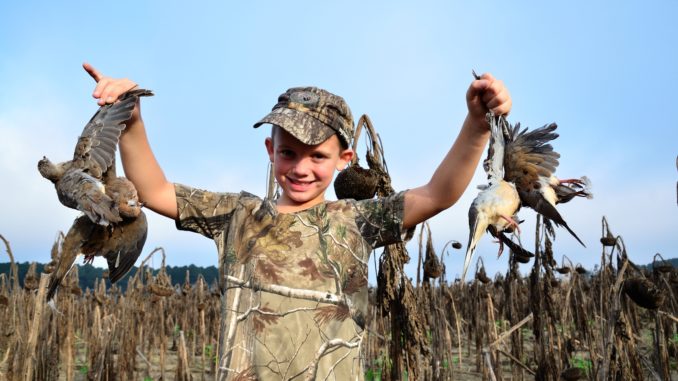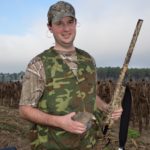
Find a good field and have your shotgun ready for a Labor Day dove shoot.
Labor Day and dove season marks the beginning of fall hunting. Just about anyone who hunts will join the action along a cut corn field armed with a shotgun and plenty of shells — at least on opening day.
The season opener engages more hunters than any other time, and for good reason. North Carolina wing-shooters are blessed with some of the best dove habitat and dove shooting in the country, and the first season can offer exceptional action if hunters prepare and choose the right places to go.
The nature of North Carolina’s agriculture and timber resources provides a perfect combination for great dove populations. Success for dove and other wildlife populations is directly linked to the quality and quantity of habitat; again, North Carolina has it, providing a huge supply of food, roosting and nesting sites that doves require to thrive.
Doves are considered migratory birds that will head north in the early spring and then back to the south in the fall based on changes in the photoperiod. However, hunters’ success over the first week of the season, beginning on Labor Day, may not have anything to do with any migratory movements.
Tom Padgett, a wildlife biologist for the N.C. Wildlife Resources Commission, said the first major migratory push may not occur until after hunters have shot a handful of limits during the first part of the season.
“(On) opening day, hunters are hunting local birds that are mostly bred here in the summer. It is not until the beginning of October through November when our migratory flocks arrive,” Padgett said. “However, a local occurrence, such as a hurricane or major frontal system may displace birds locally, shifting birds 100 miles or more within the region. The timing of the major migrations are pretty much set.”
According to Padgett, doves breed and nest prolifically through the summer, having five to seven clutches with at least two and up to four squabs (or chicks) per brood.
“Generally, birds can live a long time, but a 2- to 3-year-old dove is an old bird. Mortality is high, and 80 percent of birds are gone by age three,” he said. “In the first two weeks of the season, hunters harvest well over 50 percent of the annual hunter harvest.”
According to the U.S. Fish and Wildlife Service’s 2012 Mourning Dove Status Report, North Carolina hunters bag around 700,000 doves each season, so they’re taking nearly 350,000 doves over just a two-week period. But this same data suggests North Carolina maintains one of the largest populations of doves within the eastern United States.
The USFWS manages doves across the country in three major divisions: western, central and eastern management units. On routine breeding-bird call-count surveys conducted each summer, almost always yields the most doves per route out of 27 states from Maine to Florida and as far west as Louisiana and Wisconsin — so North Carolina is a huge player in the nationwide dove population.
Suitable habitat and prolific breeding keeps the dove populations in sync regardless of the 700,000 birds that end up in the frying pan or on the grill. Luckily, North Carolina hunters get the chance to find where the birds reside all summer well before the opening day flurry begins.
To have a successful opening week, it is critical for hunters to find birds before the season comes in and before several hundred thousand vanish out of thin air. Scouting is critical to finding potential food sources.
Keith Taylor, huntmaster of a dove-hunting organization in Robeson County called Roundtree Hunt Club, monitors fields around the region and sees where doves are spending their summer vacation, especially towards the middle to the end of August.
“Take a pair of binoculars and scout fields before the season starts and look for birds on power lines next to grain fields, especially corn. They will fall right off and feed below,” Taylor said. “Fresh-cut corn fields are the most ideal.”
In addition to doves loving the golden kernels, corn is also one of the only grain crops capable of maturing early enough to be harvested before Labor Day. According to Taylor, it takes at least five to seven days to get a flock moving to a newly-cut field, andlonger is always better to keep and bringing new flocks of birds into the field.
Taylor will not think twice about calling on local farmers to find out when they plan on harvesting their corn crops. Generally, the first few fields that get cut will draw birds from afar, and that makes these areas very productive places to hunt on opening day.
The best fields have a significant level of exposed soil. Taylor looks for fields with little weedy competition. Seeds must be distributed on the ground level without a lot of cover near the ground.
“Whether corn, sunflower, millet or sorghum, you need a clean base,” Taylor said. “Doves are concerned about predators and will stay away from food sources with weeds greater than 10 to 12 inches above their heads.”
Doves prefer to feed in fields with a last-minute vantage point immediately adjacent to the seed source to look for predators before making that final swoop towards the ground to eat.
“Power lines, irrigation pivots and even a big dead tree along a hedgerow. Nothing is better than a big dead tree. They will gravitate to these objects in a heartbeat when near food sources,” Taylor said.
Even though doves will travel several miles to find a good food source, the best are also in close proximity to a good roost site. Stands of pine and hardwoods will provide adequate roosting cover, but Padgett prefers pines.
“They really like pine timber, especially the older stands, but they will still roost in younger stands with trees around 20 feet tall,” he said. “Removing roost sites will have a direct negative impact on the dove population in the area.”
Roosting sites are critical for the success of a dove hunt. If no adequate roost sites are available within a few miles of a good food source, the likelihood of high usage by doves is slim.
Sometimes, hunters may not always get access to the perfect dove field — or any available dove field — on opening day. But they can still have good success in alternative hunting areas. Doves require water and small gravel or grit throughout the day. Gravel roads or freshly-plowed fields can offer small pebbles to fill their crop, and water can be derived from any ditch, irrigation pond or large puddle lacking thick cover. Ponds where the water levels are low or have been lowered can offer a combination small gravel, water and even some small seeds from adjacent grasses. Thorough scouting of these areas before the season arrives will allow hunters to find a secondary place to hunt.
Beyond setting up along grain fields to find birds, Padgett explains that hunters can have good success intercepting doves traveling along their main flight corridors during the early morning and late afternoons.
“Find a flight corridor between a food source and a roost, usually along wood lines. Take your time scouting and get in their flight path for a good opportunity to take a limit of birds in transit,” Padgett said.
Early season dove hunts can offer hunters spectacular wing- shooting in North Carolina. If hunters invest adequate time looking and coordinating with local landowners, the Labor Day dove hunt can produce outstanding results.







Be the first to comment